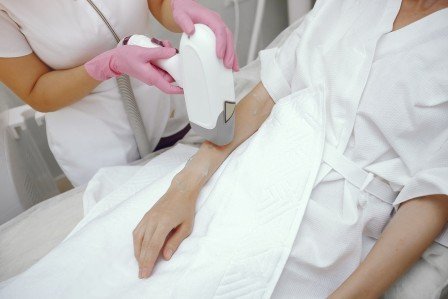What Makes Medical-Grade Laser Epilation More Effective?
Unwanted body and facial hair is a common concern across all ages and genders. While traditional methods like waxing, shaving, threading, or depilatory creams offer temporary relief, the inconvenience of constant upkeep and risk of side effects such as irritation, ingrown hairs, or razor bumps have prompted many to seek longer-term solutions.
This is where medical-grade laser epilation—also known as laser hair removal—comes in. Unlike at-home devices or salon-grade tools, medical-grade lasers provide greater precision, consistency, and safety. They’re often operated under the supervision of licensed dermatologists or trained professionals in clinical environments.
But what exactly makes medical-grade laser epilation more effective than other methods? Let’s explore the scientific, technological, and procedural factors that set it apart.


Understanding Laser Epilation
Laser epilation works by targeting melanin (the pigment) in hair follicles with focused light energy. This energy is absorbed by the melanin and converted into heat, which damages the hair follicle, delaying or inhibiting future growth.
The effectiveness of this process depends on several factors, such as the wavelength of the laser, skin type, hair color, follicle depth, and the equipment’s ability to deliver energy safely and consistently. Medical-grade lasers are engineered to optimize these variables with precision.
Key Features of Medical-Grade Laser Epilation
1. Advanced Wavelength Selection
One of the most important differentiators of medical-grade lasers is their wavelength precision. Different skin tones and hair types respond better to specific wavelengths.
- Alexandrite Laser (755 nm): Suitable for lighter skin tones with dark hair.
- Diode Laser (800–810 nm): Offers deeper penetration, ideal for a broader range of skin tones.
- Nd:YAG Laser (1064 nm): Penetrates deeply with minimal absorption by epidermal melanin, making it safer for darker skin tones.
Medical-grade devices can use multiple wavelengths or offer selective wavelength targeting, increasing their adaptability to individual skin and hair profiles.
2. Higher Power Output
Medical-grade devices are capable of delivering higher energy densities compared to consumer or salon models. This higher power ensures that the laser can effectively reach and damage the root of the hair follicle, particularly when treating coarse or deeply rooted hair.
Importantly, this is done without compromising safety. Built-in cooling systems and advanced skin detection technologies help prevent burns or pigmentation issues, even at higher energy levels.
3. Consistent Fluence and Pulse Duration
- Fluence refers to the energy delivered per unit area. Medical-grade lasers maintain consistent fluence levels across the treatment zone.
- Pulse duration (the time the laser stays on a given spot) is carefully controlled to match the thermal relaxation time of the hair follicle, minimizing collateral damage to the surrounding skin.
This precision means fewer missed follicles and more consistent long-term results.
4. Customizable Settings Based on Skin Type
One size does not fit all in laser hair removal. Factors such as skin tone, hair thickness, and treatment area significantly affect outcomes. Medical-grade systems come with customizable settings that can be finely tuned for each patient.
Before initiating treatment, professionals often assess the skin using tools like the Fitzpatrick Skin Type Scale to determine the safest and most effective approach. The ability to adjust parameters such as fluence, pulse duration, and repetition rate in real-time ensures a tailored experience for every individual.
5. Built-In Cooling Mechanisms
Safety is paramount in any laser-based procedure. Medical-grade lasers often come equipped with dynamic cooling devices (DCD) or contact cooling tips that cool the skin immediately before, during, or after the laser pulse.
This cooling:
- Reduces discomfort during the session
- Protects the outer layers of the skin
- Minimizes the risk of thermal injury or pigmentation issues
Such features allow for higher energy delivery without increasing patient discomfort or side effects.
6. Operated in a Clinical Environment
Unlike over-the-counter devices or low-powered tools in salons, medical-grade laser epilation is typically performed in a controlled, clinical setting under the guidance of trained professionals. This ensures:
- Accurate assessment of skin and hair type
- Selection of the most appropriate device and settings
- Close monitoring of the skin’s response during and after treatment
- Immediate management of any complications or side effects
Clinical expertise also contributes to the treatment’s success rate by ensuring the correct laser protocols are followed for each body area.
Treatment Outcomes: Why Medical-Grade Means Better Results
1. Faster Hair Reduction
Thanks to their higher power and precision, medical-grade devices can damage a greater number of follicles in each session. This leads to faster and more noticeable results, often requiring fewer sessions compared to lower-grade tools.
2. Reduced Risk of Side Effects
Because settings are calibrated to each person’s skin type and hair density, and because of integrated cooling systems, side effects like burns, hyperpigmentation, and scarring are significantly reduced.
3. More Effective for Resistant Hair
Medical-grade lasers can effectively treat coarse, dense, or hormonally driven hair growth, which often resists traditional methods. Areas like the chin, chest, or bikini line often respond better to the deeper penetration and stronger energy of clinical lasers.
4. Better Long-Term Maintenance
With a greater ability to destroy hair follicles completely or push them into extended dormancy, medical-grade lasers offer longer-lasting smoothness and reduced need for touch-up sessions.
Medical-Grade vs. At-Home and Salon Laser Devices: What Sets Them Apart?
When choosing a laser hair removal option, it’s helpful to understand how medical-grade lasers differ from at-home devices and salon-grade machines. Let’s break down the key differences:
1. Power Output
Medical-grade lasers deliver a higher level of energy to effectively target and disable hair follicles. In contrast, at-home devices are low-powered for safety reasons, which often limits their effectiveness. Salon lasers typically offer moderate power but don’t match the strength or consistency of clinical-grade systems.
2. Wavelength Precision
Advanced clinical lasers are designed to operate on multiple wavelengths, allowing professionals to customize the treatment based on skin tone and hair color. Most at-home and salon tools are limited in this aspect, often using a single fixed wavelength that may not work well for all users.
3. Customization Options
One of the biggest advantages of medical-grade systems is their flexibility. Practitioners can adjust settings like energy level, pulse duration, and repetition rate to suit the unique needs of each patient. At-home devices usually come with minimal or no customization, and salons offer limited adjustment depending on the brand of device.
4. Skin Cooling and Safety Features
Clinical lasers are equipped with advanced cooling systems that protect the skin and enhance comfort during treatment. These features are either missing or far less effective in salon and at-home devices, increasing the risk of burns or irritation—especially for people with sensitive or darker skin tones.
5. Level of Expertise
Medical-grade treatments are performed by licensed professionals in a clinical setting. This ensures precise assessments, safe procedures, and immediate response to any skin reactions. On the other hand, at-home treatments are self-administered with no professional support, and salons may or may not employ medically trained staff.
6. Suitability for All Skin Types
Devices like the Nd:YAG laser used in clinical settings are designed to treat darker skin tones safely. At-home and some salon devices carry a higher risk of hyperpigmentation or burns on darker complexions due to lack of adequate wavelength control.
7. Long-Term Results
Because of their strength and customization, medical-grade lasers often achieve faster and longer-lasting results. At-home and salon treatments generally require more sessions and maintenance due to lower efficacy.
Who Can Benefit the Most from Medical-Grade Epilation?
Medical-grade laser epilation is ideal for:
- Individuals with coarse or dense hair
- Those experiencing ingrown hairs or folliculitis
- People looking for permanent or long-term hair reduction
- Patients with sensitive skin who react to waxing or shaving
- Individuals with darker skin tones, when the correct technology is used
Even for those who have tried and failed with over-the-counter solutions, clinical lasers offer a fresh opportunity for success.
Pre-Treatment and Post-Treatment Considerations
Before Treatment:
- Avoid sun exposure or tanning products for at least 2 weeks.
- Shave the treatment area (avoid waxing or plucking).
- Do not apply lotions, deodorants, or cosmetics to the area on the day of treatment.
After Treatment:
- Apply a soothing moisturizer or aloe gel.
- Avoid hot showers, saunas, and excessive sweating for 24–48 hours.
- Use broad-spectrum sunscreen to protect the treated area.
- Avoid exfoliating or scrubbing for a few days.
Final Thoughts
Medical-grade laser epilation stands out as a highly effective, safe, and customizable solution for those seeking long-term hair removal. With superior technology, adjustable parameters, built-in cooling systems, and professional oversight, these lasers offer better outcomes with fewer complications across all skin types.
If you're seeking a more reliable and longer-lasting alternative to traditional hair removal methods, clinical laser epilation with medical-grade devices is a choice grounded in science, safety, and precision.

